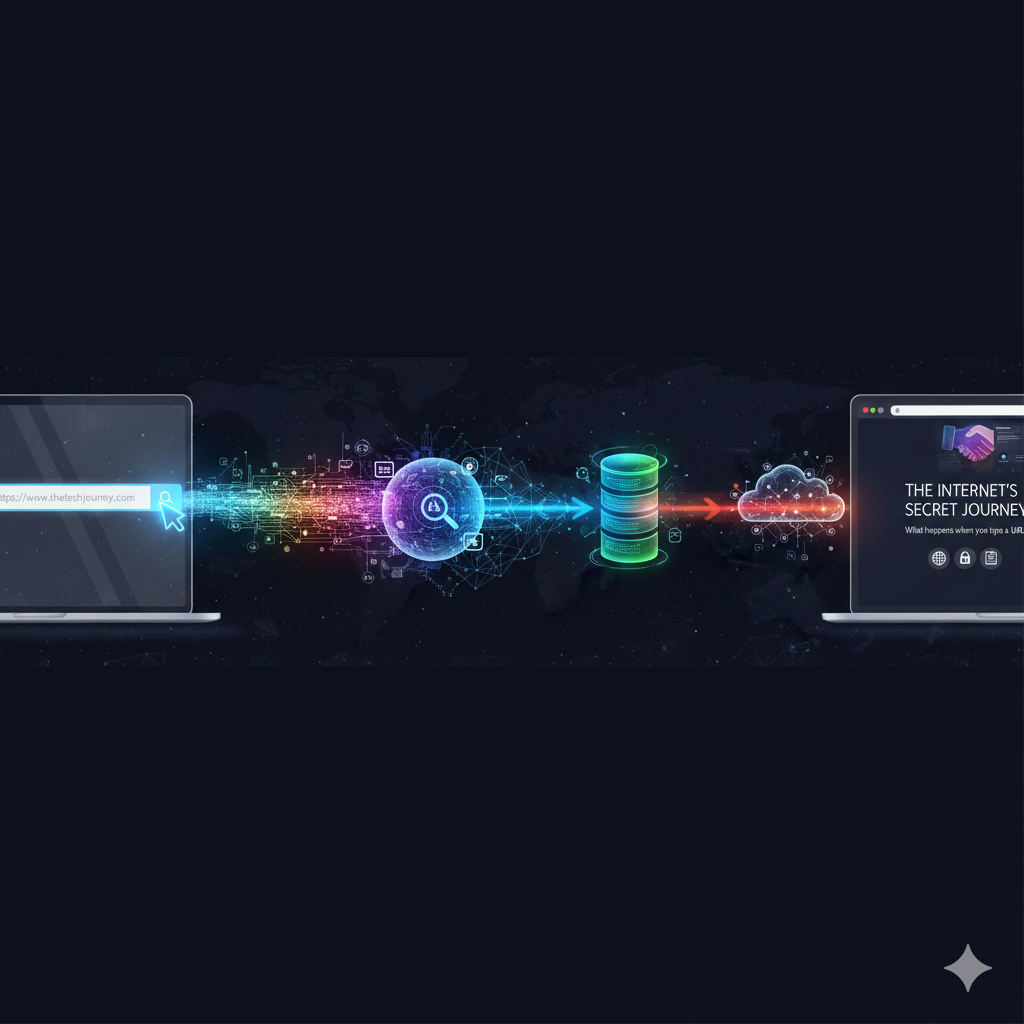It’s 10:00 p.m. You’ve got your laptop open, a cup of coffee half gone, and a head full of curiosity.
You type in the address bar:
www.google.com
You press Enter.

And like magic — before you can even blink — a page appears.
Search box. Logo. Familiar colors.
You don’t think twice about it… but if you’re an engineer at heart, you can’t help but wonder:
What just happened behind the scenes?
How did that simple line of text summon a living, breathing web page from somewhere in the digital universe?
Let’s follow your browser on its little adventure.
Chapter 1: The Awakening
The moment you press Enter, your browser comes alive — like a tiny detective handed a case file.
It studies the clue you’ve given it: a URL.
In our story, that’s https://www.google.com.
The browser decodes it piece by piece:
- “HTTPS” — that’s how we’ll talk, securely.
- “www.google.com” — that’s who I need to talk to.
- Everything after the slash (if any) — that’s what I need to ask for.
Now it knows what to fetch. But there’s one big problem…
It doesn’t know where Google actually lives.
Chapter 2: The Search for the Address
The browser scratches its head and thinks,
“Google.com? I need an IP address — a real, numeric location.”
So it heads to the DNS system — the internet’s gigantic phonebook.
It might ask your computer first (your system might remember from a past visit).
If not, it travels to your local router. Still no luck? Then it heads deeper — to your Internet Service Provider’s DNS servers, and beyond.
Finally, it finds the answer:
142.250.190.14.
Got it. Now it knows exactly where to go.
Chapter 3: Knocking on the Door
Armed with the IP address, the browser travels across networks, cables, and routers — leaping through miles of fiber-optic lines in milliseconds.
It finally reaches Google’s front door — a server waiting in a vast data center somewhere on Earth.
But before they start talking, there’s a ritual to follow: a handshake.
Since it’s HTTPS, they perform a TLS handshake — confirming identities, exchanging keys, and agreeing on how to keep the conversation secret.
It’s like two spies verifying each other’s code words before sharing intel.
Handshake complete. Connection secure. They trust each other now.
Chapter 4: The Request
The browser clears its throat and says politely:
GET / HTTP/1.1
Host: www.google.com
In human terms: “Hi! I’d like to see your homepage, please.”
Along with this message, it might send cookies, user preferences, and other helpful data — little bits that personalize the response.
Chapter 5: The Reply
On the other side, Google’s servers spring into action.
They check what you’ve asked for, maybe talk to a few internal services, query some databases, and finally assemble a response.
Then they send it back — packaged neatly in an HTTP response:
HTTP/1.1 200 OK
Content-Type: text/html
Followed by… a flood of content.
HTML, CSS, JavaScript — the building blocks of a webpage, flying back to your laptop in packets of data.
The browser starts catching them one by one.
Chapter 6: The Artist at Work
Now the browser becomes a painter.
It takes the HTML and builds the DOM, the skeleton of the page.
It reads the CSS and adds colors, fonts, and layout — giving the page its personality.
Then it runs the JavaScript, bringing everything to life with movement, clicks, and interactivity.
Meanwhile, more requests go out — for images, logos, maybe even fonts.
It’s a flurry of activity, but it all happens in milliseconds.
And then…
the masterpiece appears before your eyes: Google’s homepage.
Chapter 7: Memory and Magic
Before wrapping up, the browser makes a note:
“I’ll remember some of this for next time.”
It stores DNS information, images, and scripts in its cache — so the next visit will be lightning fast.
You, meanwhile, sip your coffee and move on to your next search — unaware that your browser just performed a global relay race through networks, servers, and encryption layers… all in the blink of an eye.
Epilogue: Why This Matters
If you’re an aspiring engineer, there’s something poetic about this process.
A simple URL triggers dozens of invisible systems — networking, cryptography, backend logic, frontend rendering — all working together to make the web feel effortless.
Every click you make is the result of decades of engineering brilliance, thousands of lines of code, and millions of engineers working in harmony.
So the next time you hit Enter, remember:
You’re not just browsing the web.
You’re witnessing one of humanity’s most impressive creations in motion — and one day, you could be the one improving it.
Keep exploring. Keep building.
Every great engineer started with a single question like this one —
“What really happens when I type a URL in my browser?”
Now you know the story.
The next chapter? That’s yours to write.
Leave a Reply